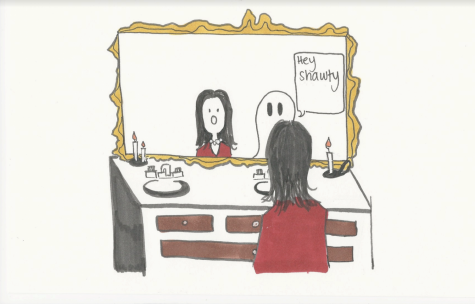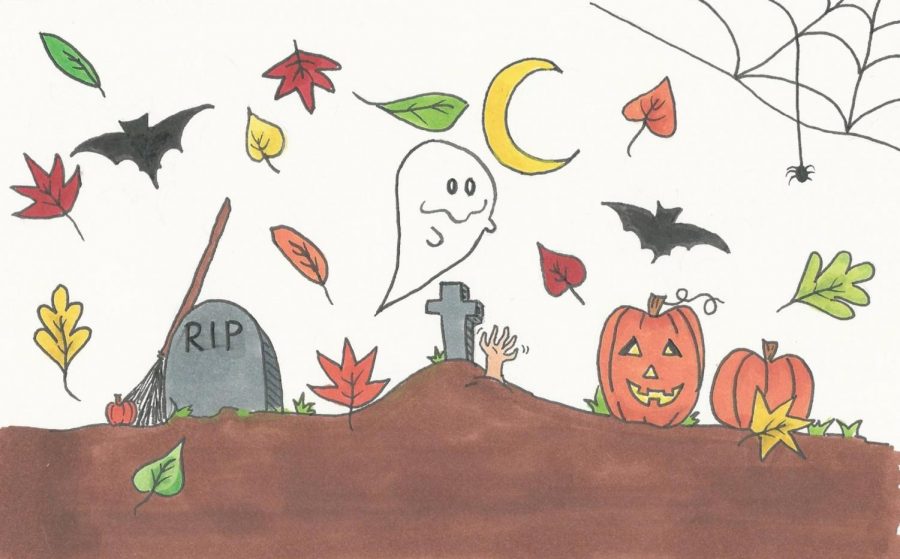The spooky Hallow’s Eve history
Our modern day Halloween descended from various ancient traditions and festivals from nearly 2,000 years ago! Drawing by: Yasmin Myers
November 10, 2020
From carved beets to eerie rituals, our modern day Halloween is rooted in ancient traditions.
The Halloween holiday we know today has changed quite a bit from the Celtic celebrations that took place 2,000 years ago. All Hallow’s Eve or Halloween can be best described as a quilt comprising different religious, cult and cultural aspects.
The celebration back then, called Samhain, consisted of people who would light bonfires to honor the dead during the new start of their new year on Oct. 31. The Celtic celebrators believed that the veil between the physical world and the spirit world would cease to exist during Samhain, thus allowing interaction between humans and Otherworldly spirits. They would sometimes wear costumes and masks to scare away or confuse evil ghosts.
The association of bats when referring to Halloween can also be traced to the ancient celebration. The bonfires Celtics would light attracted a variety of bugs which additionally attracted bats, as bugs were and remain one of their food sources.
By 43 A.D., most Celtic territory was conquered by the Romans. The Romans had a similar holiday to remember the dead named Feralia. Feralia took place in February, and Romans would place offerings and gifts on gravestones.

Sophomore Reece Pickett shared that he was familiar with the Celtic history behind the holiday. Pickett also added that, “I love Halloween! Not only is it [a] time to decorate your house with carved pumpkins, fake graveyards and spider webs, but it’s also the time when you can eat a ton of candy and people won’t think you’re weird.”
Sophomore Olivia Roman shared that she remembers, “Going shopping with my friends for a costume and watching scary movies,” from past Halloween years.
The Catholic churches’ influence upon Europe rose during the 7th century, and Samhain was frowned upon as it was considered a pagan holiday. The Vatican then merged Samhain with another religious holiday–All Saints Day–to honor the deceased.
All Hallows Eve, or Halloween, was initially forbidden to observe among early American colonists and puritans, as they also believed it was far too pagan. However, by the 1800’s, significantly more American harvest festivals began to incorporate certain elements of Halloween.
From the 1700’s to 1800’s, some women would perform rituals on All Hallow’s Eve in hopes of finding a husband. One of the rituals consisted of throwing apple peels over their shoulders and speculating the shape of the peel to determine the initials of their future husband. Women also believed that standing in a dark room in front of a mirror would allow for their future husbands’ faces to appear. Spooky!
Our modern jack-o-lanterns descend from the Irish legend of Stingy Jack. According to Irish folklore, Stingy Jack invited the Devil to have a drink with him. Staying true to his name, Jack didn’t want to pay for his drink and convinced the Devil to turn into a coin so that he may pay for his drink. The Devil complied, and Jack quickly put the coin into his wallet which bore a crucifix, stripping the Devil of his powers, and only released him after he promised not to take Jack’s soul. Eventually Jack died, and was neither allowed into Heaven, nor did the Devil take his soul because of their promise. The Devil instead gave Jack a single ember from Hell which he put in a carved beet to light Jack’s way as he roamed around trying to lure the living to their deaths in hopes of seeing the Devil again.
After the Irish potato famine, Irish immigrants soon brought the legend to America, and would celebrate by, at first, carving faces into vegetables like beets, rutabaga, and potatoes, and soon switched over to pumpkins which were native to America.








![Lindsay Guzik, new assistant principal said, "I am settling in [at VHS] pretty well. I know a lot of the students, so that makes it a little bit easier coming from Cabrillo, and it's been nice to see them all grown up." Photo by: Abraham Kassa](https://thecougarpress.org/wp-content/uploads/2025/09/IMG_9728-300x200.jpg)
